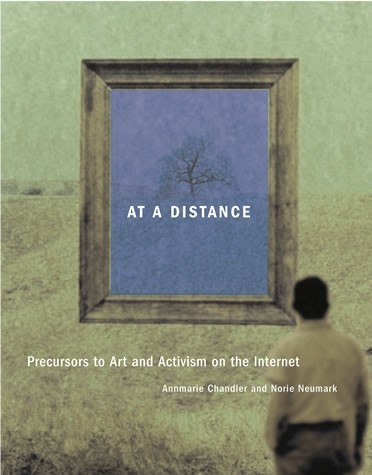Lisa Nakamura, Peter Chow-White (eds.): Race After the Internet (2011)
Filed under book | Tags: · biotechnology, code, identity, image, interactivity, internet, race

“In Race After the Internet, Lisa Nakamura and Peter Chow-White bring together a collection of interdisciplinary essays exploring the complex role that digital media technologies play in shaping our ideas about race. Contributors interrogate changing ideas of race within the context of an increasingly digitally mediatized cultural and informational landscape. Using social scientific, rhetorical, textual, and ethnographic approaches, these essays show how new and old styles of race as code, interaction, and image are played out within digital networks of power and privilege.
Race After the Internet includes essays on the shifting terrain of racial identity and its connections to social media technologies like Facebook and MySpace, popular online games like World of Warcraft, YouTube and viral video, WiFi infrastructure, the One Laptop Per Child (OLPC) program, genetic ancestry testing, and DNA databases in health and law enforcement. Contributors also investigate the ways in which racial profiling and a culture of racialized surveillance arise from the confluence of digital data and rapid developments in biotechnology. This collection aims to broaden the definition of the “digital divide” in order to convey a more nuanced understanding of access, usage, meaning, participation, and production of digital media technology in light of racial inequality.”
Contributors: danah boyd, Peter Chow-White, Wendy Chun, Sasha Costanza-Chock, Troy Duster, Anna Everett, Rayvon Fouché, Alexander Galloway, Oscar Gandy, Eszter Hargittai, Jeong Won Hwang, Curtis Marez, Tara McPherson, Alondra Nelson, Christian Sandvig, Ernest Wilson.
Publisher Taylor and Francis, 2011
ISBN 0415802369, 9780415802369
352 pages
Review: Patti (Reviews in Cultural Theory, 2012).
PDF (updated on 2012-12-26)
Comment (0)Annmarie Chandler, Norie Neumark (eds.): At a Distance: Precursors to Art and Activism on the Internet (2005)
Filed under book | Tags: · 1970s, 1980s, activism, art history, experimental art, fluxus, mail art, media art, network art, network culture, networks, new media, radio art, telematics

“Networked collaborations of artists did not begin on the Internet. In this multidisciplinary look at the practice of art that takes place across a distance—geographical, temporal, or emotional—theorists and practitioners examine the ways that art, activism, and media fundamentally reconfigured each other in experimental networked projects of the 1970s and 1980s. By providing a context for this work—showing that it was shaped by varying mixes of social relations, cultural strategies, and political and aesthetic concerns—At a Distance effectively refutes the widely accepted idea that networked art is technologically determined. Doing so, it provides the historical grounding needed for a more complete understanding of today’s practices of Internet art and activism and suggests the possibilities inherent in networked practice.
At a Distance traces the history and theory of such experimental art projects as Mail Art, sound and radio art, telematic art, assemblings, and Fluxus. Although the projects differed, a conceptual questioning of the “art object,” combined with a political undermining of dominant art institutional practices, animated most distance art. After a section that sets this work in historical and critical perspective, the book presents artists and others involved in this art ‘re-viewing’ their work—including experiments in ‘mini-FM’, telerobotics, networked psychoanalysis, and interactive book construction. Finally, the book recasts the history of networks from the perspectives of politics, aesthetics, economics, and cross-cultural analysis.”
Publisher MIT Press, 2005
ISBN 0262033283, 9780262033282
xiv+486 pages
Reviews: Publishers Weekly (2005), Vincent Bonin (2005), Graham Meikle (Scan, 2006), Paolo Gerbaudo (Culture Machine, 2006), Joel Slayton (Art Book, 2006), Karrie Karahalios (New Media & Society, 2006), Jennifer Way (RCCS, 2008, with responses from editors).
PDF (updated on 2019-11-22)
Comments (3)Harold Abelson, Ken Ledeen, Harry Lewis: Blown to Bits: Your Life, Liberty, and Happiness After the Digital Explosion (2008)
Filed under book | Tags: · control society, privacy, surveillance, web 2.0
“Wherever you go…whatever you say, write, photograph, or buy…whatever prescriptions you take, or ATM withdrawals you make…you are generating information. That information can be captured, digitized, retrieved, and copied –anywhere on Earth, instantly. Sophisticated computers can increasingly uncover meaning in those digital traces–understanding, anticipating, and influencingyou as never before.
Is this utopia? Or the dawning of a 1984/Brave New World horror world? Whatever you call it, it’s happening. What kind of world are we creating? What will it be like to live there? Blown to Bits offers powerful and controversial answers to these questions–and give you the knowledge you need to help shape your own digital future, not let others do it for you. Building on their pioneering joint MIT/Harvard course, the authors reveal how the digital revolution is changing everything, in ways that are stunning even the most informed experts.
You’ll discover ten paradoxical truths about digital data–and learn how those truths are overturning centuries-old assumptions about privacy, identity, and personal control.
You’ll view the indelible digital footprints you’re making when you search Google…send emails and text messages…write Microsoft Word documents…download MP3s…make cellphone calls…post blog entries…pay highway tolls…use your supermarket discount card. And you’ll see how others could be following those footprints, in ways you never thought about, and might not like.
Writing in plain English, the authors illuminate the myriad implications of the digital revolution, answering the questions you’ve wondered about–or ought to wonder about. Who owns all that data about you? What do they owe you? How private is your medical information? Is it possible to send a truly secure message? Who can you trust for accurate information when traditional media is replaced by thousands of unfiltered Internet sources?
Along the way, they reveal the decisions governments and corporations are making right now that will shape your future…and show how to have your say in those decisions. Because you have an enormous stake in the outcome. We all do.”
Publisher Addison-Wesley, 2008
Creative Commons Attribution-Noncommercial-Share Alike 3.0 United States License
ISBN 0137135599, 9780137135592
366 pages
Book website
Interview (Democracy Now!, 2009)

